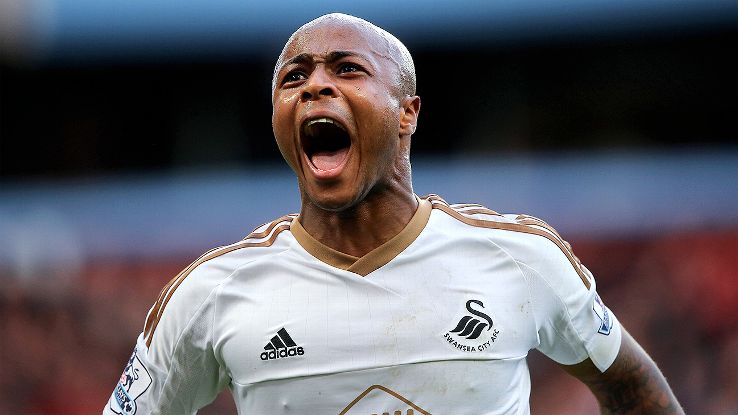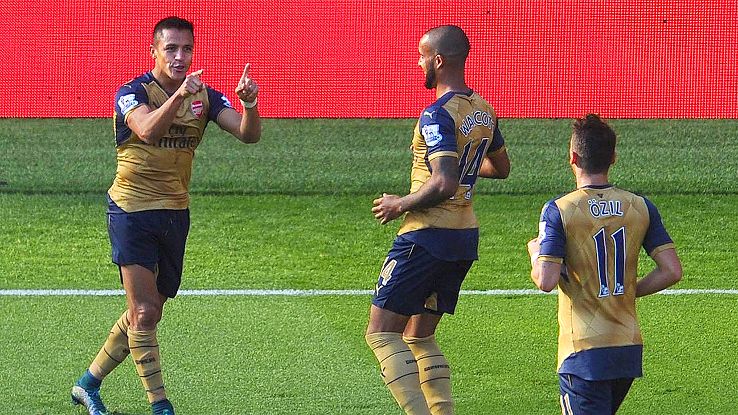How Swansea perfected Arsenal blueprint for possession football


Only one Premier League team completed the double over Arsenal last season. It wasn't one of those who finished above them in the table, Chelsea or Manchester City. Nor was it one of those scrappy, physical sides who relentlessly terrorise Arsenal with long balls and tough tackles, a side led by Sam Allardyce or Tony Pulis. It was, perhaps surprisingly, Swansea City. On Sunday, Arsenal travel to Wales hoping for revenge.
Swansea have gone through three Premier League managers since their promotion to the Premier League in 2011: Brendan Rodgers, Michael Laudrup and Garry Monk. They've also evolved from an organised and determined group of solid, reliable footballers, into a collection of genuinely top-class footballers. Four years ago, the idea of Andre Ayew and Jefferson Montero playing for Swansea would have been ludicrous; now, it seems perfectly normal.
And yet regardless of their manager, and regardless of their players, Swansea have always caused Arsenal problems. In the 10 matches in the past four years, both sides have won four games apiece, with two draws, and the aggregate score is 13-13. That's quite an achievement for a side like Swansea -- essentially Arsenal on a budget -- who haven't tried to unsettle the Gunners by exploiting their traditional weaknesses, but have instead effectively beaten Arsenal at their own game.
In many ways, Swansea are very similar to Arsenal. The insistence on playing possession-based football, building play slowly through midfield but depending upon individuals to provide a burst of pace in the final third, is something Arsene Wenger can clearly relate to. There's also an emphasis upon signing talented, technical young players, generally from abroad, and generally for reasonable sums. It's not difficult to imagine Ayew, for example, playing for the Gunners; in fact, with Arsenal's current injury problems on the right, he'd probably do a very good job.

These sides are incredibly respectful of one another, and the matches between them have a peculiarly consistent pattern. Of the 20 goals between the sides in the past three seasons, a staggering 19 have been scored after half-time. They're almost always 0-0 at half-time, and never 0-0 at full-time.
In other respects, however, Swansea have been better than Arsenal. In particular, the organisation and structure of the side is always excellent, with and without the ball. Few teams cover space as effectively as Swansea when attacking; there's precisely the right mixture of ball retention in the centre of the pitch, then attacking thrust down the flanks, in part because the players understand their positional responsibilities excellently. There's little lateral movement from Swansea -- you don't see Gylfi Sigurdsson drifting to the extent of Mesut Ozil, for example -- and minimal interchanging of positions between players.
With Montero, for example, you know he's going to hug the left touchline and go down the outside. Ayew becomes a second striker, but he doesn't drift between the lines. These are inventive players with fairly set roles.
Bafetimbi Gomis is an interesting case study. Against Arsenal last season, he scored the winner both home and away by converting crosses, and his aerial power is impressive for a player only slightly taller than six feet. The interesting thing about Gomis, though, is how frequently he's caught offside. This isn't the most commonly used football statistic, and yet it can tell you so much about a player; in Gomis' case, he's been caught offside 23 times this season.
Amazingly, no other player in the league has been caught offside more than nine times. Harry Kane and Graziano Pelle are both on nine, with Diego Costa, Marko Arnautovic and Theo Walcott on eight. Gomis, alone, has been caught offside more than 13 teams overall.
Relentlessly being caught offside is not a particularly desirable quality, and it's worth considering that Gomis has now gone seven games without a goal. Yet it says something about the way Swansea play: their striker is always looking to get in behind. He doesn't work the channels, or drift wide to combine with wingers regularly, nor does he get involved with playmaking. He stays up front, he gets in the box and yes, he often wanders in behind the opposition defence too quickly.
This is how Swansea are different to Arsenal.
At Arsenal, the duties of the attacking players overlap much more. Olivier Giroud is a traditional striker in one sense, but he's effectively a bonus playmaker with his tendency to come short and play clever flicks for onrushing teammates. Ozil, as mentioned, drifts all around the pitch while Alexis Sanchez is a one-man attacking force capable of dribbling, creating and scoring equally. The likes of Aaron Ramsey and Walcott prefer central roles but have often been fielded wide, and Santi Cazorla was forced to adjust to a deeper midfield role when his usual, more-attacking positions became increasingly crowded.

However, Arsenal have actually become much more positionally disciplined when in possession, and cover the pitch much better than a few years ago. Even when Ramsey is fielded on the right -- and naturally plays narrower than a proper wide midfielder -- he shuttles up and down in the channel rather than becoming an extra central player. Sanchez cuts inside, but usually after receiving possession up against the full-back, rather than taking up a No. 10 position to start with.
This is different to the way Arsenal once played, when players were given too much license to move between the lines. They became extremely narrow and relentlessly tried to pass through the centre of opposition defences, who were happy to crowd them out. It also left them extremely exposed to counter-attacks, because there were huge gaps for opponents to break into, and the narrowness meant it was impossible to counter-press efficiently once possession was lost.
And maybe, just maybe, Arsenal have improved by assessing Swansea's organisation. Usually when Arsenal lost to teams who play a similar style of football, it was to Barcelona, Bayern Munich or Manchester City -- teams who had greater resources. Losing to Swansea at their own game should have forced a rethink.
Arsenal currently lie second in the Premier League table, but so far they haven't actually accumulated any more points than from the equivalent fixtures last season: 22 from 10 games. In that respect, last season's double defeat to Swansea means this weekend is a perfect opportunity to demonstrate they've improved.
Michael Cox is the editor of Zonal Marking and a contributor to ESPN FC. Follow him on Twitter @Zonal_Marking.
